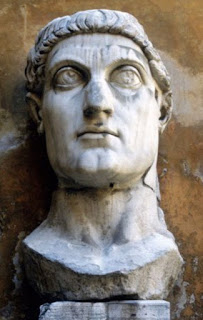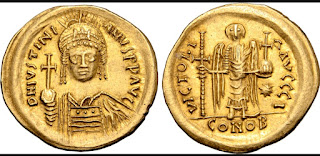The Byzantine Empire was a vast and powerful civilization with origins that can be traced to 330 AD, when the Roman emperor Constantine I dedicated a "New Rome" on the site of the ancient Greek colony of Byzantium. Though the western half of the Roman Empire crumbled and fell in 476 AD, the eastern half flourished for 1,000 more years, sprawling a rich tradition of art, literature and learning and serving as an effective military buffer between Europe and Asia. The Byzantine Empire finally fell in 1453, after an Ottoman army stormed Constantinople (present day Istanbul) during the reign of Constantine XI.
Byzantine gold coin, Basil I, 867-886 ADThe term 'Byzantine' derives from Byzantium, an ancient Greek colony founded by a man named Byzas. In 330 AD, Roman Emperor Constantine, I chose it as the site of a new Rome with a capital city of Constantinople. Five years earlier, Constantine had established Christianity, as Rome's official religion. Though Constantine ruled over a unified Roman Empire, after his death, the empire got diverged into two regions, and remained so till 476 AD, when Rome fell. The eastern emperors were more effective to combat any invasion
Even after the Islamic empire absorbed Alexandria, Antioch and Jerusalem in the seventh century, The Byzantine emperor would remain spiritual leader of most eastern Christians.
Justinian I, who ruled from 527 to 565 AD, was the first great ruler, who conquered part of the former western empire including North Africa.
In 634 AD, after Islam was founded in 622 AD, Muslim armies began their assault on the empire. By the end of the century, they would lose Syria, Egypt and north Africa to Islamic forces.
During the 8th and early 9th centuries, Byzantine emperors (beginning with Leo III in 730 AD) spearheaded a movement that denied the holiness of icons, or religious images, and prohibited their worship. Known as Iconoclasm, meaning smashing of images, the movement waxed and waned under various rulers, until 843 AD, when the Church under Emperor Michael III ruled in favour of display of religious images.
The end of 11th century saw the beginning of the Crusades, the series of holy wars waged by European Christians against Muslims, from 1095 to 1291 AD. Emperor Alexius turned to the west for help, and as armies of France, Germany and Italy poured into Byzantium they recaptured their territory.
During the reign of Michael VIII in 1261, the economy of the empire began to crumble and never recovered. In 1369, Emperor John V unsuccessfully sought financial help from the west to confront the growing Turkish threat but was arrested. Four years later he was forced to become a vassal of the Turks. They provided the Sultan tribute and military support.
Murad II in 1421 revoked all privileges and laid siege to Constantinople, and it marked an end to the empire. In 1453, the Ottoman army stormed Constantinople, entered Hagia Sophia and soon converted it into a mosque. Emperor Constantine XI died in battle that day
Long after its end, Byzantine culture and civilization continued to exercise an influence on countries that practiced its eastern orthodox religion, including Russia, Romania, Bulgaria, Serbia and Greece, amongst others.
The Walls of Constantinople. Anything written about the city is incomplete without mention of the "Wall". This was a series of defensive stone walls that surrounded and protected the city of Constantinople (today Istanbul in Turkey). With innumerable additions and modifications during their history, they were the last great fortification system and the most elaborate and complicated system in history ever built. Known as the Theodosian Walls, they saved the city through the centuries and is a study by itself.
Byzantine Coinage. The star of the Byzantine Empire was undoubtedly the gold solidus or nomisma. Introduced by Constantine in the 4th century AD, it would reign supreme as the current standard for 700 years. 72 nomismata were equal to one pound of gold. Thus, each weighed 4.4 gm of pure gold and was 21-22 mm in diameter. Even Basil II was minting them in 1020 AD.
Justinian I, Solidus, gold, weight 4.4 g, 22 mm
Obverse: Helmeted bust holding globus cruciger and shield with horseman motif, four pendilla hanging from helmet with jewels
Reverse; Angel standing, holding long jeweled cross and globus cruciger, eight-pointed star in field
The most common silver coin was the miliaresion, introduced in 720 AD, twelve of which were worth one nomisma.
The most common copper coin was the large follis introduced by Anastasios around 500 AD. 24 follis equaled one miliaresion and 288 equaled one nomisma
Justinian II (685-695 AD) was the first emperor to depict Jesus Christ on coins






















Having served in Turkey, and been conversant with their history and the region of Byzantine, including Istanbul find this a very fascinating depiction of that period.The images bring to life the bygone era.Excellent historical wealth.My compliments for a monumental effort.Maj Gen Anil SENGAR, Indian Army
ReplyDeleteKissi Din , hopefully after the madness n chaos of this pandemic I hope we can sit together and go through your collection.
ReplyDeleteWhat amazes me about these ancient coins is the exquisite art for the designing n minting of coins was even then. Maybe more so as they were the very important part of the wealth of kings and kingdoms .
Thanks for this fabulous blog n information.
Regards
Minnie